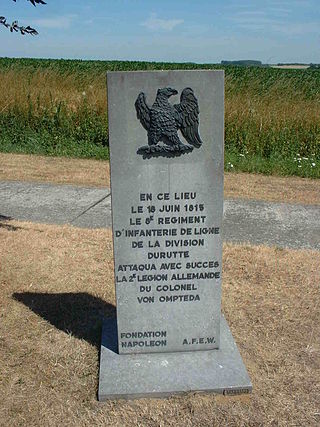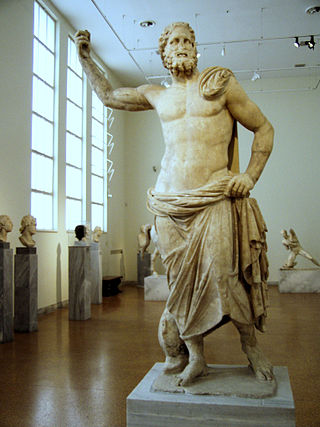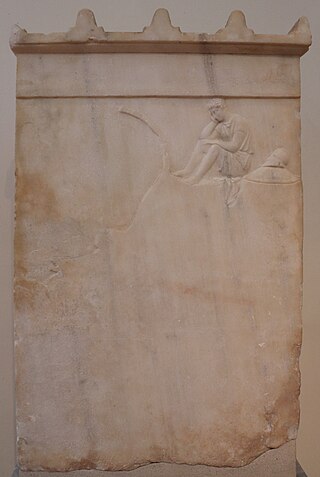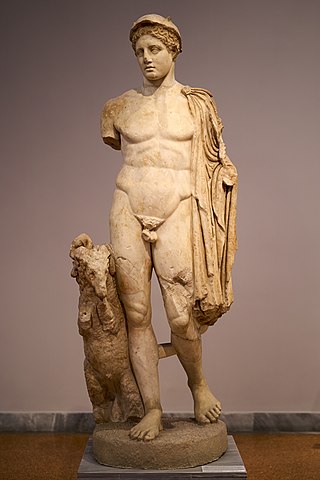
A stele, or occasionally stela when derived from Latin, is a stone or wooden slab, generally taller than it is wide, erected in the ancient world as a monument. The surface of the stele often has text, ornamentation, or both. These may be inscribed, carved in relief, or painted.

The sculpture of ancient Greece is the main surviving type of fine ancient Greek art as, with the exception of painted ancient Greek pottery, almost no ancient Greek painting survives. Modern scholarship identifies three major stages in monumental sculpture in bronze and stone: the Archaic, Classical (480–323) and Hellenistic. At all periods there were great numbers of Greek terracotta figurines and small sculptures in metal and other materials.

The Berlin Painter is the conventional name given to an Attic Greek vase-painter who is widely regarded as among the most talented vase painters of the early 5th century BC. There are no painter signatures on any of the Berlin Painter's attributed works. From the surviving vases, it is safe to assume that he was a major painter, there are over 400 vases and fragments attributed to him.

The Antikythera Ephebe, registered as: Bronze statue of a youth in the museum collections, is a bronze statue of a young man of languorous grace that was found in 1900 by sponge-divers in the area of the ancient Antikythera shipwreck off the island of Antikythera, Greece. It was the first of the series of Greek bronze sculptures that the Aegean and Mediterranean yielded up in the twentieth century which have fundamentally altered the modern view of ancient Greek sculpture. The wreck site, which is dated about 70–60 BC, also yielded the Antikythera mechanism, a characterful head of a Stoic philosopher, and a hoard of coins. The coins included a disproportionate quantity of Pergamene cistophoric tetradrachms and Ephesian coins, leading scholars to surmise that it had begun its journey on the Ionian coast, perhaps at Ephesus; none of its recovered cargo has been identified as from mainland Greece.

Delphi Archaeological museum is one of the principal museums of Greece and one of the most visited. It is operated by the Greek Ministry of Culture. Founded in 1903, it has been rearranged several times and houses the discoveries made at the Panhellenic sanctuary of Delphi, which date from the Late Helladic (Mycenean) period to the early Byzantine era.
The Phrasikleia Kore is an Archaic Greek funerary statue by the artist Aristion of Paros, created between 550 and 540 BCE. It was found carefully buried in the ancient city of Myrrhinous in Attica and excavated in 1972. The exceptional preservation of the statue and the intact nature of the polychromy elements makes the Phrasikleia Kore one of the most important works of Archaic art.

The Grave Stele of Hegeso, most likely sculpted by Callimachus, is renowned as one of the finest Attic grave stelae surviving today. Dated from c. 410 – c. 400 BCE, it is made entirely of Pentelic marble. It stands 1.49m high and 0.92m wide, in the form of a naiskos, with pilasters and a pediment featuring palmette acroteria. The relief, currently on display at the National Archaeological Museum in Athens was found in 1870 in the Kerameikos in Athens, which now houses a replica of it.

The Funerary naiskos of Aristonautes is a funerary monument dating to around 320 BC, on display in the National Archaeological Museum of Athens (NAMA) with the inventory number 738.

The Stele of Aristion dates from around 510 BC. It was created by sculptor Aristokles out of Pentelic marble and shows traces of polychrome. It was found at Velanideza near Marathon in Attica.

The Poseidon of Melos is a statue of Poseidon in the National Archaeological Museum, Athens (NAMA), with an inventory number 235, which is dated to the last quarter of the second century BC, thus to the Hellenistic Period.

The Statue of the priestess Aristonoe in the National Archaeological Museum Athens (NAMA), with the inventory number 232, dates from the third century BC.
The Funerary monument for an athlete is an Ancient Greek relief that depicts a young nude male holding two pomegranates over his head in his left hand, and an aryballos in the other. He stands facing right in profile to the viewer, with one foot stepping out in front of the other. The relief is 98 x 24 3/4 x 9 3/4 inches and is carved in marble.

The Grave Stele of Dexileos is the stele of the tomb of an Athenian cavalryman named Dexileos who died in the Corinthian War against Sparta in 394 BC. The stele is attributed to "The Dexileos Sculptor". Its creation can be dated to 394 BC, based on the inscription on its bottom, which provides the dates of birth and death of Dexileos. The stele is made out of an expensive variety of Pentelic marble and is 1.86 metres tall. It includes a high relief sculpture depicting a battle scene with an inscription below it. The stele was discovered in 1863 in the family plot of Dexileos at the Dipylon cemetery in the Kerameikos cemetery of Athens. It was found in situ, but moved during World War II, and is now on display in the Kerameikos Museum in Athens.

The Kerameikos steles are a collection of sculptures used as grave-markers in the Kerameikos necropolis of Attica. Kerameikos is located outside the Themistoclean Wall's Dipylon Gate. Stelai come in various shapes/designs and depict images varying from pottery to narrative scenes. They were often marble or limestone, and were carved or sculpted to depict the person being memorialized sometimes with relatives or slaves. Reliefs decorating the graves were meant to show the dead in their best light, using imagery to recognize their bravery in battle, or pathos, or wealth. These monuments marked the graves of Athenian men, fallen warriors, as well as non-citizens. Women were also included in Kerameikos but typically it was the wealthiest or prominent women who were given stele. In many vase paintings of grave scenes wreaths are seen resting at the base of stele. This was likely a popular way to adorn the graves of loved ones.

The Merenda Kouros is a Late Archaic Greek Kouros, created approximately 540-530 B.C., measuring 1.89 meters tall and made of Parian marble. As of the present day, it is exhibited in the Sculpture Collection of the National Archaeological Museum, Athens.

The Funerary Stela of Demokleides is a funerary monument on display at the National Archaeological Museum, Athens.

The Three-Bodied Daemon or the Three-Bodied Monster is an ancient Greek sculpture in typical early Archaic period style, once part of the west pediment of the Hekatompedon temple in the Acropolis of Athens. Today it is housed in the Acropolis Museum in Athens, Greece. It is made of limestone, and it is remarkable for the large amount of colour pigment on it that has survived.

Hermes Criophorus is a marble sculpture of the second century AD depicting the Greek god Hermes, as god of pasture and shepherds, carrying away a young ram. The sculpture is a Roman copy of a Greek original of the fifth century BC. It was discovered in Troezenia in southern Greece in late nineteenth century, and it is now part of the collection of the National Archaeological Museum in Athens.

The Apollo Omphalos is an ancient Roman marble copy of a Greek original bronze sculpture in typical early Archaic period style, depicting Apollo, the Greek god of music, medicine, and prophecy. Today it is housed in the National Archaeological Museum of Athens, in Greece. The sculpture was found in several fragments which were put together, and bears several signs of damage.

The Funerary naiskos of Demetria and Pamphile is a tomb memorial in honour of two deceased women named Demetria and Pamphile, erected in Athens in around 320 BC, shortly after Pamphile's death. It is made of marble and now kept at the Kerameikos Archaeological Museum in Athens, Greece, with inventory number P687, while a copy of it is found on the ancient site of the tomb.



















